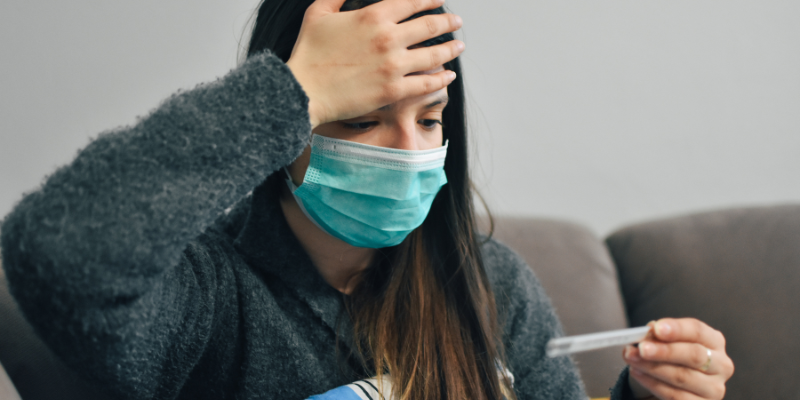
Even though stay-at-home orders are easing, and many counties and states are re-opening for business, a number of people are still feeling anxious about leaving home. You may be one of them. But how can you tell if you’re just being appropriately cautious, or if you’re developing the mental health condition known as agoraphobia?
What Is Agoraphobia?
Agoraphobia is an anxiety disorder that is characterized by an overwhelming and irrational fear of specific places, situations, or spaces. According to the National Institute of Mental Health (NIMH), an estimated 1.3% of U.S. adults will experience agoraphobia at some point in their lifetime. People who experience the condition often feel trapped or think they won’t be able to escape from places like a crowded elevator, an airplane, or even a wide-open space like the beach. When in these situations, people with agoraphobia can feel intense anxiety and may experience symptoms of a panic attack.
The dread of experiencing that panic and anxiety while in these places and situations can make your world become smaller. You may feel compelled to stick to familiar routes or to stay within a specific “safety zone.” Over time, that safety zone may shrink until you feel unable to leave your home without experiencing extreme anxiety.
This can have devastating consequences on all aspects of your life, including personal relationships, career, school, and physical health.
Is the Quarantine Creating Agoraphobia?
Agoraphobia is very different from staying at home due to the global response to the coronavirus pandemic. However, the pandemic may be contributing to an increase in agoraphobia.
Months of sheltering at home due to the pandemic, combined with non-stop news reports about the threat of contracting COVID-19 from other people or from high-touch surfaces, has created a perfect storm for agoraphobia. In people who were already at increased risk for the condition, the pandemic and quarantine may have pushed them over the edge.
Factors that increase the risk of agoraphobia include:
- Having another anxiety disorder, such as panic disorder, generalized anxiety disorder, or obsessive compulsive disorder
- A family history of anxiety disorders or phobias
- Having depression
- Having other phobias, such as hypochondria (fear of illness), mysophobia (fear of dirt and germs), or nosocomephobia (fear of hospitals)
- Exposure to trauma
- Traumatic brain injuries (TBIs)
- Learned responses, which is when parents with phobias transfer their fears to their children
- Exposure to toxins, such as toxic mold
- Chronic infections, such as Lyme disease
How Quarantine is Affecting People who Already Have Agoraphobia
In people already affected by agoraphobia, the pandemic and stay-at-home orders may have triggered an increase in the severity of symptoms. People who were previously managing their condition may be suffering more in the current situation.
Simply hearing news about the possibility of shortness of breath or having difficulty breathing from COVID-19 may remind them of the symptoms they experience when panicked, which can be anxiety-provoking. The notion of self-isolation can fuel fears of being trapped or unable to get help if needed. And warnings about the risk of contracting COVID-19 in crowds can trigger heightened anxiety in people who are already panicky about such situations.
Agoraphobia in the Brain
Functional brain imaging studies show that agoraphobia and other phobias are not mental health problems. Rather, they are brain health problems that steal your mind. Functional brain imaging studies using SPECT technology show that people with phobias, such as agoraphobia, tend to have excessive activity in an area of the brain called the basal ganglia. Other biological changes in the brain have also been noted.
At Amen Clinics one patient was housebound for 40 years before venturing out of her home to get a brain scan. Seeing the abnormal activity in her brain helped her understand that her fears were not her fault and that improving her brain health could help heal her life.
Ways to Manage Agoraphobia
Agoraphobia is manageable, even while sheltering at home during a pandemic. Adopting the following brain healthy lifestyle habits can make a difference:
- Avoid caffeine, alcohol, and nicotine
- Engage in physical activity on a regular basis, but avoid high-intensity exercise that may trigger anxiety
- Get at least 7 hours of sleep each night
- Eat nutritious foods and avoid sugary sweets
- Practice meditation or prayer to calm an anxious brain
- Stay connected with friends and family even if you can’t visit in person
- Consider brain-boosting supplements, such as a high-quality multiple vitamin-mineral complex, omega-3 fatty acids, and vitamin D
If you venture out of your home and begin feeling panicky—whether it’s at the grocery store, in a park, or in your own neighborhood—follow these 4 steps:
- Slow your breathing. By taking slow, deep breaths you’ll boost oxygen to your brain and start to regain control over how you feel.
- Don’t leave. If you leave, you give that place or situation power over you.
- Write down your thoughts. If your thoughts are distorted, talk back to them.
- Take calming supplements or medication to help, if needed. Remember that this is the last step—to be used if the first 3 aren’t effective.
When to Seek Help
Seeking treatment is important if you feel like you are slipping over the edge from being cautious about developing agoraphobia. The earlier you get treatment the better. And if you already have agoraphobia and your symptoms are worsening, don’t hesitate to reach out for support from a professional.
Agoraphobia and other phobias, as well as other forms of anxiety, can’t wait. During these uncertain times, your mental well-being is more important than ever, and waiting until life gets back to “normal” is likely to make your symptoms worsen over time.
At Amen Clinics, we’re here for you. We offer in-clinic brain scanning and appointments, as well as mental telehealth, remote clinical evaluations, and video therapy for adults, children, and couples. Find out more by speaking to a specialist today at 888-288-9834. If all our specialists are busy helping others, you can also schedule a time to talk.





No Comments »
No comments yet.
RSS feed for comments on this post.
Leave a comment